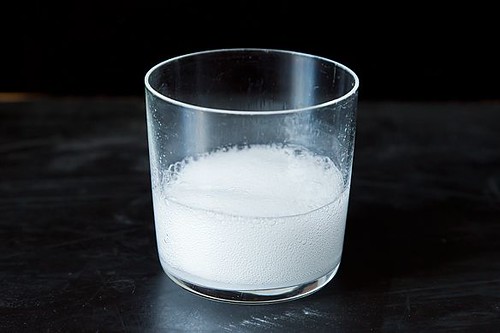pH scale levels are measurements of acidic acid.
The following image is what a pH scale typically looks like (including examples for each level)...
So...what?
They usually range between 0 and 14, with 7 being the average pH.
H+=OH- (OH is a hydroxide)
pH=7
H=OH=H2O
So just a few little facts about these "ph levels"...
- We tend to have things that are a little bit higher in pH levels. The pH of blood and saliva and most of the body fluids are used to being in a specific sort of pH. They must be kept very much in control.
- Pure water is a neutral pH level. So when products are mixed in with water, the mixture can become acidic or basic.
- Lots of foods tend to be acidic. Brussel sprouts, tangy foods, coffee, oranges, vinegar, and etc. (as seen in the above image)
- Your body prefers a very specific level of pH.
So Let's Experiment!!!
What do we need?
- vinegar
- 25 mL grad. cylinder
- universal pH paper
- mortar and pestle crushing device
- 4 beakers or cups, 50 mL volume
- several coffee stirrers
- 1/2 teaspoon + tablespoon measure spoons
- baking soda + 3 other antacids with different active ingredients
- clock with second hand
- data records
Let's get started!
First, Then we measured the pH level of vinegar, which came out to be pH level 4. Then, 4 little cups were filled with 25 mL of vinegar and lined up to be tested.
The average dosage of antacids of the two provided brands (Equate and Rolaids) was 2 tablets.
Next, my group squished up 2 equate brand antacid tablets into the little bowl. We added the mixture to one of the four cups of 25 mL vinegar. The reaction was very bubbly! The pH level for this came out to be 6.
 Then we mashed 2 Rolaid tablets and threw them into a second cup of the 25 mL vinegar. This, too, came out to be 6 on the pH scale.
Then we mashed 2 Rolaid tablets and threw them into a second cup of the 25 mL vinegar. This, too, came out to be 6 on the pH scale.
So NOW, we must put in some baking soda to the vinegar mixture! What happens? This reaction is pretty bubbly too, but settles down, unlike the previous two tests. The pH level tested here cam out to be 6, also.
NOW for Equate's Liquid Antacid!! We poured 5 mL of this into the vinegar. No bubbly reaction came here, but the mixture took a cloudy look. The pH level of this mixture in particular was 3.

So according to my results, the three antacids had the same reaction. They all brought the pH level up to 6. So really, you can pick from any of these antacids to use!
"Whooptydoo! But what does it all mean, Basil?"
What does this all mean? Well, think about these acids in your stomach and how they work. You should have a pretty good idea why too much of a certain thing can give you a pretty bad stomach ache now!
So, from this lesson, we can learn to watch out for the certain mixtures we take in to our bodies. We must be very careful-or else we can have a super bubbly reaction!
Enjoy! :)
So according to my results, the three antacids had the same reaction. They all brought the pH level up to 6. So really, you can pick from any of these antacids to use!
"Whooptydoo! But what does it all mean, Basil?"
What does this all mean? Well, think about these acids in your stomach and how they work. You should have a pretty good idea why too much of a certain thing can give you a pretty bad stomach ache now!
So, from this lesson, we can learn to watch out for the certain mixtures we take in to our bodies. We must be very careful-or else we can have a super bubbly reaction!
Enjoy! :)


This was a good post. You described your experiment short and to the point, and explained what your results were and how you got them. You also seemed to know what you were talking about. I don't know many of the terms you used, but you wove them into a solid analysis nicely.
ReplyDeleteA point about this you may want to think about is to try and describe what the reaction of the vinegar to the antacid tablets were because you described them both pretty similar. The reason you may want to think about it is because they were both described pretty similar. You might have wanted to say that if it was bubbly very quickly or not as much and what color did both the reactions take?
ReplyDeleteThis post was very interesting,it kept me reading.You could have elaborated about the reactions that happened.
ReplyDelete